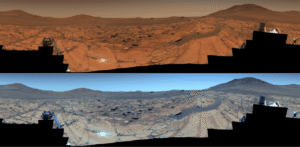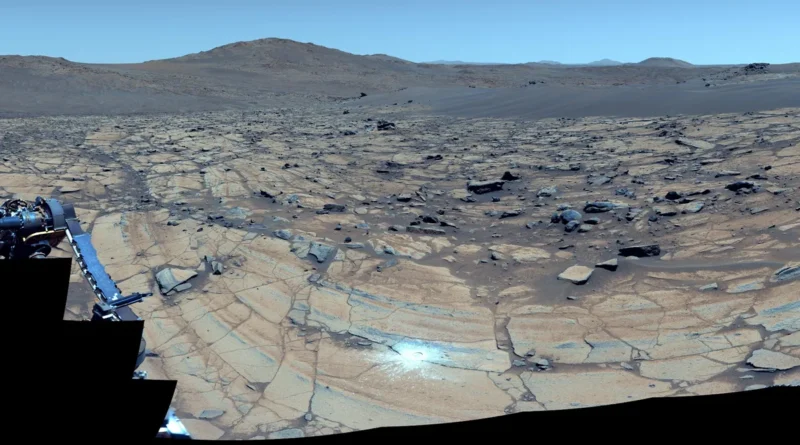5 Awe-Inspiring Views of Mars Under Earth-Like Sky – NASA’s Latest Reveal!
For the first time, NASA’s Perseverance rover is giving us a glimpse of Mars under Earth-like sky conditions. The agency stitched together 96 images from Perseverance’s Mastcam-Z camera to create a full 360° panorama of Jezero Crater’s rugged “Falbreen” region. In the enhanced version of this panorama, the sky is tinted a vivid blue, making Mars look surprisingly familiar. NASA even describes the colorized mosaic as having “deceptively blue skies” – a deliberate effect. Of course, this is a processing trick, not an actual change in Mars’s atmosphere, but the result is breathtaking.
In fact, Perseverance’s science team captured this panorama on Sol 1,516 of the mission (May 26, 2025) when the Martian skies were unusually clear. The crisp image spans rugged bedrock and hills up to 40 miles (65 km) away. Jim Bell (Mastcam-Z principal investigator) explained that they “enhanced the color contrast” in this mosaic to make surface details pop against the sky. In the raw scene the sky would look orange-red, but the processed photo invites us to imagine Mars under an Earth-like sky. It blends real data with artistic colorization, giving us an almost dreamlike view of the Red Planet.
Why Mars’s Sky Isn’t Really Blue

Of course, Mars’s real sky is very different from Earth’s. The Red Planet’s thin atmosphere is filled with fine iron-rich dust, which normally absorbs blue sunlight and makes the sky appear reddish or pinkish. As NASA scientists note, Martian dust “absorbs blue light, giving the sky its red color,” and only at sunrise or sunset does some blue scattering appear. In daytime, the sky typically looks butterscotch or light orange, not cerulean. Space.com even warns: “Mars’s skies never appear blue like Earth’s, and only appear to be blue in the panorama due to processing”.
In reality, seeing Mars under Earth-like sky remains a human fantasy – but the new panorama lets our imaginations play.
Key Features of the Panorama:
-
Blue-tinged Sky: The standout is the rich blue sky. NASA’s enhanced-color mosaic deliberately shifts the horizon to blue, creating a “deceptively blue” Martian sky in the image This tint mimics an Earth-like sky under clear daylight.
- Float Rock on Ripple: Toward the center-right is a large “float rock” perched on a curved sand ripple. Geologists say this rock was likely carried here from elsewhere on Mars (by ancient water, wind, or a landslide). Its presence atop the ripple hints at the planet’s dynamic history.
- Drilled Rock Patch: A bright white circle near the scene’s center is Perseverance’s 43rd abrasion patch. The rover ground away surface dust with its drill to reveal fresh rock beneath. This patch shows Mars’s rusty weathering contrasted with the gray interior of the rock.
- Ancient Terrain: This view lies in an area the team calls “Falbreen,” which contains some of the oldest rock Perseverance has studied. Seeing such ancient terrain helps scientists piece together Mars’s deep past.
- Distant Horizons: Because the panorama covers 360°, it even shows hills on the far rim as much as ~40 miles (65 km) away. Those distant ridges under the blue sky make the scene feel vast and Earth-like.
For students and enthusiasts, this image is both visually stunning and scientifically rich. Every feature – from the color-enhanced sky to the geological details – tells a story.
Imagining Life Under an Earth-Like Martian Sky
What if you could walk on Mars under a blue sky? Thanks to Perseverance’s data, we can begin to imagine it. Picture stepping out onto red dust and gazing up at pastel blue – a sight that blurs the line between Mars and home. NASA’s Acting Administrator Sean Duffy captured the excitement: “Stunning vistas like that of Falbreen… are just a glimpse of what we’ll soon witness with our own eyes” as humans push toward Mars. For now, enjoying Mars under Earth-like sky is something we do with our eyes and imagination, inspired by this breathtaking panorama. It reminds us that exploration is as much about wonder as it is about science.
Beyond the Blue: What This Means for Exploration
This colorized panorama does more than look beautiful – it fuels our curiosity. It shows that even alien worlds can feel familiar under the right perspective. By contrasting the enhanced and natural images, NASA scientists highlight the real dust-filled sky versus an Earthy blue one. The result sparks interest in Mars’s atmosphere, geology, and future missions. It also underscores NASA’s broader goals: as Duffy said, missions like Artemis are preparing the way for people to one day see Mars in person under whatever sky awaits.
Whether or not humans ever breathe Martian air, the idea of Mars under Earth-like sky is inspiring. It demonstrates how imagery can blend rigorous science with creative vision. This panorama is a gift to sky-gazers and students – a reminder that our universe can surprise us with beauty. For more on Perseverance and the Red Planet.
Mars under Earth-like sky may be a colorized fantasy today, but it brings us a step closer to feeling at home on another world. Each new image from Perseverance connects science with imagination, making the Red Planet’s vistas feel a little more familiar and a lot more inspiring.
Sources: NASA’s Jet Propulsion Laboratory image release and mission updates
Space.com coverage of the panorama
When Is the Next Full Moon? Your Complete 2025 Guide
See 6 Planets Align in the Night Sky This August – Don’t Miss It


Pingback: New Uranus Moon Discovered: 29th Satellite Found by Webb Space Telescope
Pingback: What Are Inner Planets? 4 Incredible Rocky Planets of Our Solar System